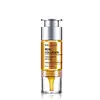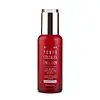What's inside
What's inside
 Key Ingredients
Key Ingredients

 Benefits
Benefits

 Concerns
Concerns

No concerns
 Ingredients Side-by-side
Ingredients Side-by-side

Water
Skin ConditioningGlycerin
HumectantPropanediol
Solvent1,2-Hexanediol
Skin ConditioningPolyglycerin-3
HumectantCaprylic/Capric Triglyceride
MaskingMethylpropanediol
SolventHydrolyzed Collagen
EmollientLaminaria Japonica Extract
Skin ProtectingEclipta Prostrata Leaf Extract
Skin ConditioningAvena Sativa Kernel Extract
AbrasiveCynara Scolymus Leaf Extract
Skin ConditioningPteris Multifida Extract
AntioxidantLupinus Albus Seed Extract
Skin ConditioningHelianthus Annuus Seed Oil
EmollientHydrogenated Lecithin
EmulsifyingSodium Hyaluronate
HumectantNiacinamide
SmoothingCyclohexasiloxane
EmollientDipropylene Glycol
HumectantAmmonium Acryloyldimethyltaurate/Vp Copolymer
Xanthan Gum
EmulsifyingGlyceryl Polymethacrylate
Fructooligosaccharides
HumectantCarbomer
Emulsion StabilisingBeta-Glucan
Skin ConditioningDisodium EDTA
Adenosine
Skin ConditioningPolyquaternium-51
Skin ConditioningTromethamine
BufferingHydrolyzed Hyaluronic Acid
HumectantTocopherol
AntioxidantEthylhexylglycerin
Skin ConditioningWater, Glycerin, Propanediol, 1,2-Hexanediol, Polyglycerin-3, Caprylic/Capric Triglyceride, Methylpropanediol, Hydrolyzed Collagen, Laminaria Japonica Extract, Eclipta Prostrata Leaf Extract, Avena Sativa Kernel Extract, Cynara Scolymus Leaf Extract, Pteris Multifida Extract, Lupinus Albus Seed Extract, Helianthus Annuus Seed Oil, Hydrogenated Lecithin, Sodium Hyaluronate, Niacinamide, Cyclohexasiloxane, Dipropylene Glycol, Ammonium Acryloyldimethyltaurate/Vp Copolymer, Xanthan Gum, Glyceryl Polymethacrylate, Fructooligosaccharides, Carbomer, Beta-Glucan, Disodium EDTA, Adenosine, Polyquaternium-51, Tromethamine, Hydrolyzed Hyaluronic Acid, Tocopherol, Ethylhexylglycerin
Water
Skin ConditioningGlycereth-26
HumectantDipropylene Glycol
HumectantDimethicone
EmollientCyclopentasiloxane
EmollientCyclohexasiloxane
EmollientPentaerythrityl Tetraethylhexanoate
EmollientHydrolyzed Collagen
EmollientSophora Japonica Fruit Extract
Skin ConditioningCassia Italica Leaf Extract
Skin ConditioningEnteromorpha Compressa Extract
Skin ProtectingCodium Tomentosum Extract
Skin ProtectingMacrocystis Pyrifera Extract
Skin ConditioningLaminaria Japonica Extract
Skin ProtectingGelidium Cartilagineum Extract
Skin ProtectingNiacinamide
SmoothingAdenosine
Skin ConditioningBetaine
HumectantAllantoin
Skin ConditioningArginine
MaskingCarbomer
Emulsion StabilisingPolysorbate 60
EmulsifyingEthylhexylglycerin
Skin ConditioningButylene Glycol
HumectantCaprylyl Glycol
EmollientPropanediol
Solvent1,2-Hexanediol
Skin ConditioningDisodium EDTA
Parfum
MaskingWater, Glycereth-26, Dipropylene Glycol, Dimethicone, Cyclopentasiloxane, Cyclohexasiloxane, Pentaerythrityl Tetraethylhexanoate, Hydrolyzed Collagen, Sophora Japonica Fruit Extract, Cassia Italica Leaf Extract, Enteromorpha Compressa Extract, Codium Tomentosum Extract, Macrocystis Pyrifera Extract, Laminaria Japonica Extract, Gelidium Cartilagineum Extract, Niacinamide, Adenosine, Betaine, Allantoin, Arginine, Carbomer, Polysorbate 60, Ethylhexylglycerin, Butylene Glycol, Caprylyl Glycol, Propanediol, 1,2-Hexanediol, Disodium EDTA, Parfum
Ingredients Explained
These ingredients are found in both products.
Ingredients higher up in an ingredient list are typically present in a larger amount.
1,2-Hexanediol is a synthetic liquid and another multi-functional powerhouse.
It is a:
- Humectant, drawing moisture into the skin
- Emollient, helping to soften skin
- Solvent, dispersing and stabilizing formulas
- Preservative booster, enhancing the antimicrobial activity of other preservatives
Adenosine is in every living organism. It is one of four components in nucleic acids that helps store our DNA.
Adenosine has many benefits when used. These benefits include hydrating the skin, smoothing skin, and reducing wrinkles. Once applied, adenosine increases collagen production. It also helps with improving firmness and tissue repair.
Studies have found adenosine may also help with wound healing.
In skincare products, Adenosine is usually derived from yeast.
Learn more about AdenosineCarbomer is a polymer of acrylic acid. Its main role is to create a gel consistency.
A high amount of carbomer can cause pilling or balling up of products. Don't worry, most products contain 1% or less of carbomer.
Cyclohexasiloxane is a type of silicone more commonly known as D6. It is an emollient and solvent.
Cyclohexasiloxane is used to evenly distribute ingredients throughout the product. When applied to the skin, Cyclohexasiloxane evaporates and leaves behind a silky feel.
As an emollient, it can help the skin feel soft and hydrated. It is also used to reduce frizz in hair products.
Learn more about CyclohexasiloxaneDipropylene Glycol is a synthetically created humectant, stabilizer, and solvent.
This ingredient helps:
Dipropylene glycol is technically an alcohol, but it belongs to the glycol family (often considered part of the ‘good’ alcohols). This means it is hydrating and gentle on skin unlike drying solvent alcohols like denatured alcohol.
As a masking agent, Dipropylene Glycol can be used to cover the smell of other ingredients. However, it does not have a scent.
Studies show Dipropylene Glycol is considered safe to use in skincare.
Learn more about Dipropylene GlycolDisodium EDTA plays a role in making products more stable by aiding other preservatives.
It is a chelating agent, meaning it neutralizes metal ions that may be found in a product.
Disodium EDTA is a salt of edetic acid and is found to be safe in cosmetic ingredients.
Learn more about Disodium EDTAEthylhexylglycerin (we can't pronounce this either) is commonly used as a preservative and skin softener. It is derived from glyceryl.
You might see Ethylhexylglycerin often paired with other preservatives such as phenoxyethanol. Ethylhexylglycerin has been found to increase the effectiveness of these other preservatives.
Hydrolyzed collagen has a misleading name because it is actually a mixture of various proteins/peptides. This ingredient has skin hydrating properties.
Collagen is the most abundant type of structural protein found in your body. In your skin, it is responsible for keeping it firm and youthful.
Hydrolyzed Collagen is created by breaking up proteins into smaller peptide bonds. These peptides act as humectants and emollients.
Humectants are great at holding onto water, keeping skin hydrated. Emollients create a thin barrier on the skin to prevent moisture from escaping.
There is ongoing debate about whether hydrolyzed collagen works because it increases skin hydration. Skin hydration is also linked to elasticity and the appearance of wrinkles.
Collagen or peptide ingredients can be used in the morning or night. They will not increase sun sensitivity, but you should always wear sunscreen during the day.
According to a manufacturer, this ingredient is a great hair conditioner as well.
This ingredient can be extracted from different sources, including:
Vegan collagen is derived from yeast, bacteria, or plant sources. Vegan collagen would go by a different INCI name, such as hydrolyzed soy protein.
The results are varied.
A study from 2021 found hydrolyzed collagen increased elasticity and improved wrinkles in 1,125 participants between age 20 and 70. Another study found increased skin thickness in participants between the ages of 45 to 59.
However, It is difficult to prove that oral collagen will end up working on your skin. Many of the studies using hydrolyzed collagen also add several vitamins and nutrients into the test mixture as well.
Further studies are needed at this time.
Learn more about Hydrolyzed CollagenLaminaria Japonica Extract comes from a kelp more commonly known as 'sweet kelp'. It is commonly eaten in Japan, Korea, and China.
Sweet kelp is a humectant and helps hydrate your skin. Humectants draw moisture from the air to your skin.
Studies show Laminaria Japonica has antioxidant compounds. Antioxidants may help with anti-aging. Kelp also contains magnesium and zinc, making it great for calming inflammation and redness.
Learn more about Laminaria Japonica ExtractNiacinamide is a multitasking form of vitamin B3 that strengthens the skin barrier, reduces pores and dark spots, regulates oil, and improves signs of aging.
And the best part? It's gentle and well-tolerated by most skin types, including sensitive and reactive skin.
You might have heard of "niacin flush", or the reddening of skin that causes itchiness. Niacinamide has not been found to cause this.
In very rare cases, some individuals may not be able to tolerate niacinamide at all or experience an allergic reaction to it.
If you are experiencing flaking, irritation, and dryness with this ingredient, be sure to double check all your products as this ingredient can be found in all categories of skincare.
When incorporating niacinamide into your routine, look out for concentration amounts. Typically, 5% niacinamide provides benefits such as fading dark spots. However, if you have sensitive skin, it is better to begin with a smaller concentration.
When you apply niacinamide to your skin, your body converts it into nicotinamide adenine dinucleotide (NAD). NAD is an essential coenzyme that is already found in your cells as "fuel" and powers countless biological processes.
In your skin, NAD helps repair cell damage, produce new healthy cells, support collagen production, strengthen the skin barrier, and fight environmental stressors (like UV and pollution).
Our natural NAD levels start to decline with age, leading to slower skin repair, visible aging, and a weaker skin barrier. By providing your skin niacinamide, you're recharging your skin's NAD levels. This leads to stronger, healthier, and younger looking skin.
Another name for vitamin B3 is nicotinamide. This vitamin is water-soluble and our bodies don't store it. We obtain Vitamin B3 from either food or skincare. Meat, fish, wheat, yeast, and leafy greens contain vitamin B3.
The type of niacinamide used in skincare is synthetically created.
Learn more about NiacinamidePropanediol is an all-star ingredient. It softens, hydrates, and smooths the skin.
It’s often used to:
Propanediol is not likely to cause sensitivity and considered safe to use. It is derived from corn or petroleum with a clear color and no scent.
Learn more about PropanediolWater. It's the most common cosmetic ingredient of all. You'll usually see it at the top of ingredient lists, meaning that it makes up the largest part of the product.
So why is it so popular? Water most often acts as a solvent - this means that it helps dissolve other ingredients into the formulation.
You'll also recognize water as that liquid we all need to stay alive. If you see this, drink a glass of water. Stay hydrated!
Learn more about Water